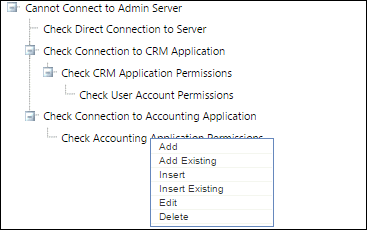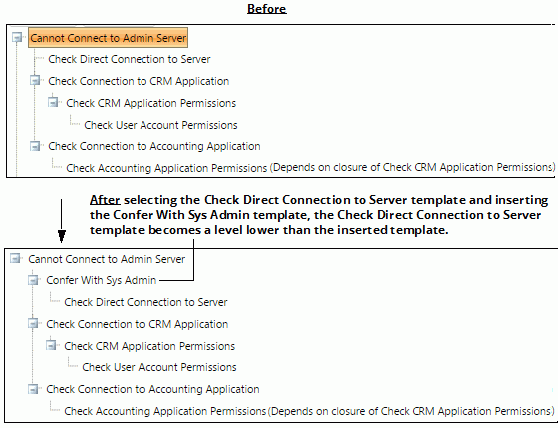You can use the Add, Add Existing, Insert, and Insert Existing links to create larger hierarchies as shown in the example below. It is useful to chart your template structure using a white board to ensure that it is logical and complete. Note that there is no limit to the number of templates in a hierarchy.

You would use the following steps to create the workflow:
Use the New link to create and save the Cannot Connect to Administration Server template.
Select the Cannot Connect to Administration Server template and click the Add link.
Create and save the Check Direction Connection to Server template.
Select the Cannot Connect to Administration Server template and click the Add link. Create and save the Check Connection to CRM Application template.
Select the Check Connection to CRM Application template and click the Add link.
Create and save the Check CRM Application Permissions template.
Select the Check CRM Application Permissions template and click the Add link.
Create and save the Check User Account Permissions template.
Select the Cannot Connect to Administration Server template and click the Add link. Create and save the Check Connection to Accounting Application template.
Select the Check Connection to Accounting Application template and click the Add link.
Create and save the Check Accounting Application Permissions template.
In addition to the dependency created when you add or insert a template, you can define a dependency on a template that is not on a level directly below the specified template. In the following example, a dependency can be defined for the Check Accounting Application Permissions template so that an incident will not be created from it until an incident created from the Check CRM Application Permissions template is closed.

To define this type of dependency, you would first select the template (Check Accounting Application Permissions in this example) and click the Edit link. In the Hierarchy Template screen, click the Depends on Closure of Incidents Created From link on the Advanced tab. In the Select Hierarchy Template Dependency dialog, select the template from which an incident must be closed before an incident will be created from current template. Continuing with the example, you would select the Check CRM Application Permissions template.

The dependency is noted next to the template title in the View Hierarchy Templates screen.

Note: When you use the Edit link to change a template, the change will not be reflected in any other hierarchies that use the template. Incidents already created from the template are not affected; however, future incidents created from the template will reflect the change.
When you use the Add Existing link to add an existing template to a hierarchy, a copy of the existing template is placed a level under the selected template and changes can be made if necessary. If the template that is copied includes lower level templates, those templates are also copied.
Once you have created a workflow hierarchy, you can use the Insert and Insert Existing links to insert a copy of a template into it. The inserted template will be placed above (as a parent to) the selected template, pushing the selected template down a level. If the template to be inserted includes lower level templates, those templates are also copied.
In the example below, if you were to select the Check Direct Connection to Server template, click the Insert link, and create and save a template, the template hierarchy would look like the following.
